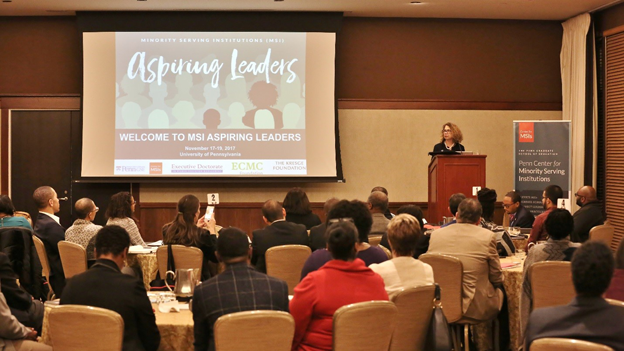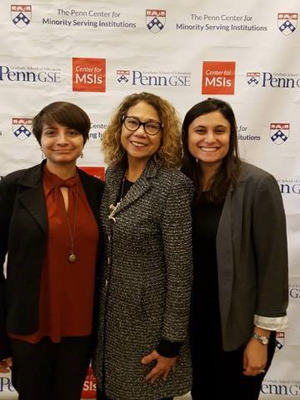Mentors Helped California State University Fullerton President Achieve the American Dream; Now She's Giving Back
November 21, 2017

If you are looking for a dose of inspiration, meet President Mildred García.
A testament to the American Dream, California State University, Fullerton's (CSUF) president was once a young professional who didn't believe that she – a woman of color – could ever lead an institution of higher education.
That's because more than 70 percent of college presidents are men, and 80 percent are white. But, through hard work and perseverance, Dr. García beat the odds and became the first Latina president in the largest system of public higher education in the country.
Breaking glass ceilings, however, requires more than just hard work, degrees, credentials and perseverance – it takes a village.
Her inspiration and support first came from her parents, who taught her that education was the gateway out of poverty. At home, her parents often repeated the mantra: "La única herencia que una familia pobre le deja a sus hijos es una buena educación." The only inheritance a poor family leaves its children is a good education.
In the 1940s, believing that more opportunity was waiting for them in the states, Dr. García's family made the ultimate sacrifice of leaving their home in Puerto Rico behind. They settled in Brooklyn's housing projects and worked in its factories to carve a better future for their seven children.
After Brown v. Board of Education, Dr. García was given the opportunity to attend better-funded schools that gave her more educational opportunities. These experiences inspired her to fight for other students from low-income, underrepresented backgrounds like her.
"I have dedicated my life to this. I work at institutions that serve students like me," she said. "I see myself in these students, and believe that all students should have the opportunity to reach their dreams."
In addition to her parents, Dr. García's mentors have been influential in helping her navigate to and through three college presidencies.
In the late-1990s, Dr. García participated in the Millennium Leadership Initiative, run by the American Association of State Colleges and Universities. A leadership development program, it provides mentorship and skill-building opportunities for aspiring leaders in higher education. The program proved to be successful: Dr. García went on to become the first president in their program's first cohort.
Giving Back, Inspiring the Next Generation of MSI College Presidents

Dr. García is not just helping students like her become successful but mentoring future college presidents as well.
"There are not enough underrepresented individuals and women in the presidencies at our institution," she said. "There is so much amazing talent and I want to help them explore opportunities to lead colleges and universities across the country."
In addition to working as a mentor in the Millennium Leadership Initiative, she is one of 15 mentors of the Penn Center for Minority Institutions (CMSI)'s MSI Aspiring Leaders Forum and Mentorship program (MSI Aspiring Leaders).

ECMC Foundation College Success team members Angela Sanchez (left) and Sarah Belnick (right) with Dr. García.
Supported by ECMC Foundation and Kresge Foundation, MSI Aspiring Leaders aims to prepare the next generation of MSI presidents. The program brings together college presidents and mid-career aspiring leaders in higher education and includes a leadership forum and two-year mentorship program. The three-day forum provides professional development workshops focused on 21st century skills and discussions on topics such as the presidential nomination process, managing relationships with faculty, strategic fundraising, management and more. Following the forum, mentors (college presidents) and mentees (aspiring presidents) work together one-on-one to address topics and issues that the mentee might face in his or her college presidency.
Last weekend at the program's inaugural forum in Philadelphia, Dr. García delivered the keynote address. In a room full of aspiring presidents, she told the story of her family's journey from Puerto Rico to New York, her career in higher education, and the importance of leadership programs like MSI Aspiring leaders.
"The path is never easy, and I have discovered early on in my journey that women and people of color must check all the boxes, have all the credentials, and be up to date and published on all the latest research and grants just to get a seat at the table," said Dr. García.
"It's not fair that there are those looking for reasons to exclude us, but it is our reality, compounding our responsibility to become the leaders we aspire to be. And yet, we stand on the shoulder of individuals who opened the doors for us and we must continue to open doors to others."
In January 2018, Dr. García will assume the role of President at the American Association of State Colleges and Universities, where she plans to advocate for aspiring and current college presidents at state and public higher education institutions across the country. She leaves behind a record-breaking legacy of graduating 11,000 students at CSUF – among them, 60 percent are first-generation college students – within her six-year tenure at the university.
Tips for Aspiring College Presidents from Dr. García
At the forum, Dr. García provided the following tips in her keynote to aspiring leaders:
- Self-reflection: "Before you begin down the path of a presidency, enter into introspection. Ask yourself why do you want to become president? What are your values and your goals?"
- Right Location: "Find the right school. Find an institution that suits your skills, matches your passion and is populated with the students you want to serve."
- Right Timing: "Not only must it be the right institution with the right students that align with your passion and skillset, it must also be the right time for you personally."
- Diverse Team: "We want to walk the talk and if we ask our campus constituencies to diversify their faculty and staff, then we must assemble the best in the business on our teams that happen to be diverse."
- Giving Back: "Give back by being mentors – from former students to colleagues you're matched up with through national [mentorship] programs."
Did you enjoy this grantee spotlight? Read more grantee spotlights here.
